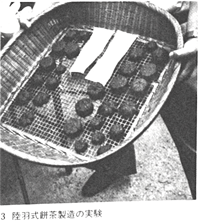◀ previous session | next session ►
Tea cakes made in an effort to imitate tea cake forming as described in the Cha jing
Session 16: Tang China ④: Tea practices
Topics
◊ Tea cultivation, crafting, preparation, consumption, trade during the Tang dynasty
Thoughts—read before class, revisit for tests
Most of the content of this lecture is based on Evans, Tea in China. The comments on cultivation are probably fairly accurate. He says they are based on the Si Shi Zuan Yao (四時纂要). This is a Tang dynasty agricultural work. As an historical document its provenance is pretty solid but it is difficult to tell whether Evans uses it directly or via secondary (Western language) scholarship that summarizes passages.
This lecture is not as on-point with regard to the themes of this course; rather, it tries to give some historical details along the "tea basics" component of this course. I have not marked this topic as a study topic for exams, however, I do this the below key points are important enough to warrant possible inclusion of exams:
Regarding cultivation, techniques are improved and stimulated by Tang state policy (for increased production) and imperial tribute tea.
Regarding crafting, leaves are steam-heated (a type of kill-green process but probably not sophisticated) then mashed, to make tea cakes. These are pierced, sun-dried to some extent, the oven-dried, then stored. This "wet" heating process differs from most Chinese approaches now, but is similar to Japan processing.
Overall, if I would link this to the main topic of the course (history of culture of tea), I think the best way to look at consider how Tang Buddhist practices and the growth of Buddhism in general,Tang imperial sponsorship of tea cultivation, Tang international trade practices, Lu Yu's Cha jing, and technical advances in agriculture and tea cuisine of the time interact to move tea culture far forward.
Required—to be completed for today's session
✓ There is no required reading; however, attendance is recommended since most of this information is accessible only through the lecture.
Multimedia notes
❖ None.
Links
⇢ This article (via MUSE) discusses the role of women in cultivating tea: "Beyond the Paradigm: Tea-picking Women in Imperial China" (Weijing Lu, 2004). It is not exclusively about Tang dynasty practices but includes them.
Other
In preparing this lecture I came across this interesting Wiki Tang Dynasty comment: "Although wrapping paper had been used in China since the 2nd century BC, during the Tang Dynasty the Chinese were using wrapping paper as folded and sewn square bags to hold and preserve the flavor of tea leaves." This cites a work with an appealing title: Joseph Needham, Science and Civilization in China: Volume 5, Chemistry and Chemical Technology, Part 1, Paper and Printing, Taipei: Caves Books 1986. Just sharing.
Links to each session page
Sun, Sept 1, 2013: I am migrating this site to a new site. It takes time. During this transition, there are two ways to access a particular day's web page. You can start with the new EA109 Fall 2013 Course Guide page, our official top page. It will take you directly to the new pages and redirect to old pages when necessary. Or you can use the below chart. It will take you directly to the day's session page—the new one when it exists, the old one when it has yet to be migrated. Greenhighlight means the new page exists. Sorry for the dust and mess during construction!
Aug 30, F S01
Sep 4, W S02
Sep 6, F S03
Sep 9, M S04
Sep 11, W S05
Sep 13, F S06
Sep 16, M S07
Sep 18, W S08
Sep 20, F S09
Sep 23, M S10
Sep 25, W S11
Sep 27, F S12
Sep 30, M S13
Oct 2, W S14
Oct 4, F S15
Oct 7, M S16
Oct 9, W S17
Oct 11, F S18-Midterm
Oct 14, M S19
Oct 16, W S20
Oct 18, F S21
Oct 21, M S22
Oct 23, W S23
Oct 25, F S24
Oct 28, M S25
Oct 30, W S26
Nov 1, F S27
Nov 4, M S28-Midterm
Nov 6, W S29
Nov 8, F S30
Nov 13, W S31
Nov 15, F S32
Nov 18, M S33
Nov 20, W S34
Nov 22, F S35
Nov 25, W S36
Nov 27, F S37
Dec 2, M S38-Midterm
Dec 4, W S39
Dec 6, F S40
Dec 9, M (RRR)
Dec 11, W (RRR)
Dec 13, F (RRR)
Dec 19 3-6PM, Th FINAL

